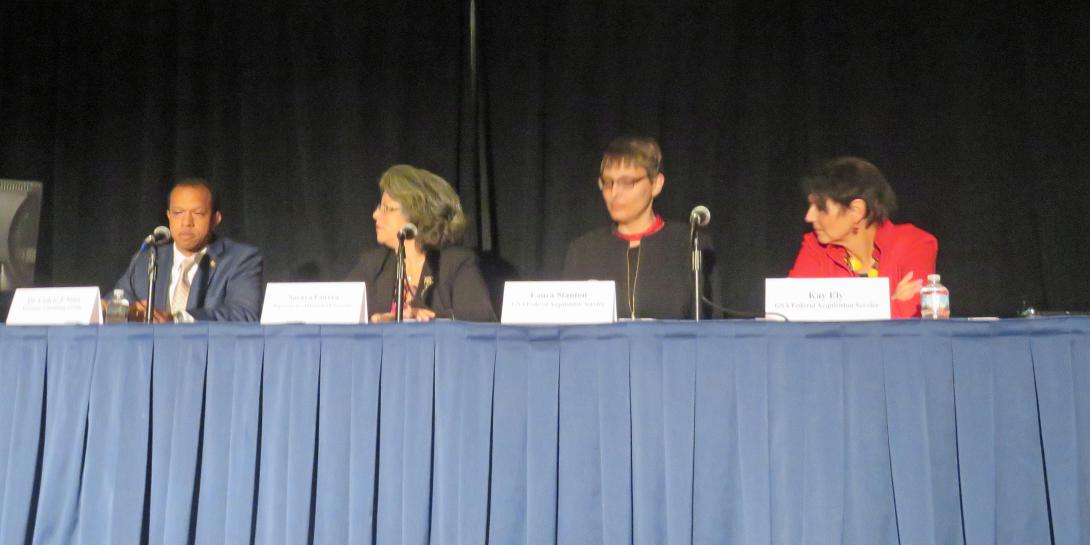Unity of Effort Leading Acquisition Plans
Unified solutions to the government’s acquisition challenges best serve the mission, and that is how DHS, GSA and other federal agencies are making progress in acquisition and procurement reforms.
Great thinking is going on in procurement, but more importantly agencies are coming together in business solutions, stated Soraya Correa, chief procurement officer, DHS, speaking on a DHS procurement panel at AFCEA’s Homeland Security Conference.
“What we have focused on is coming together as a team and integrating our functions” as part of the department’s unity of effort push, she added.
DHS is trying to do a better job of communicating internally and externally, making sure people know the department's goals and objectives and how they can help, she explained. The work is more collaborative.
Correa also said she is proud of the efforts involved with the hurricanes. “We can always find ways to do it better, but it is efficient and effective and all about homeland security.”
Representing GSA acquisition on the panel, Laura Stanton assistant commissioner, Office of Strategy Management, joined Kay Ely, deputy assistant commissioner, Office of Information System Category, in expressing similar thoughts about goals and progress at their agency.
As an organization, GSA is bringing together traditional acquisition as well as innovation and a strong engagement, according to Stanton. If the acquisition vehicles do not serve the needs of customers, then GSA is not doing its job, Ely added.
Correa warned that at some point you might not have the right mix in a contracting vehicle. Performance or technology might have shifted over the years. The vehicles may be in place, but the technology might be different, she suggested.
“Procurement is more agile than people think. We have room to make changes where we can.”
Correa continued, “If there is a vehicle that we can tap to do a type of work that will meet our needs, we use it. If not, then we look at do we write our own vehicle? And if so, do we write one for across the spectrum or to the environment specifically?”
The GSA knows how to buy, but doesn't always know how industry is selling. If the department spends time planning up front, sometimes weeks, then industry is going to be much more likely to respond, she added.
The GSA’s acquisition gateway goal is to shorten the procurement cycle, said Stanton. The online system has been developing for three years. Through it, acquisition reports across the government can be used to shorten the cycle. It has been accessed more than 50,000 times by industry so far and is useful for companies as they figure out responses for request for information responses.
Strategic sourcing includes strong collaboration between vehicles in different organizations. It is actually strategic solution sourcing, and it is all about the solution. It is being a lot smarter about how things are bought across the enterprise, stressed Ely. The governmentwide strategic solution goes back to performance. The government needs to put some thought into performance-based acquisition as a community. Start with the end in mind, and start thinking in terms of the what instead of the how, she said.
Stanton acknowledged the difficulty of the conversations and the time commitment needed across agencies to find consensus on strategical sourcing with real requirements and commitments. Correa agreed that reaching consensus can be hard not only across agencies but also within an agency.
Cedric Sims, president and CEO of Evermay Consulting Group and panel moderator, shifted the conversation to the work force, noting that whenever a program is running well, it can be traced back to a fantastic program manager. However, not everyone has the same skill coming out of the gate. He challenged the panel to explain what their agencies are doing to address work force development and training.
Correa outlined the acquisition professionals career program in her agency. It is a three-year program where the interns come in as a team and go through training together. They learn from subject matter experts. For the first three years, she said, they work for her. Then, when they graduate the program, they are hired out into other agencies.
“We as leadership of organizations have to develop people and give them opportunity to learn,” she stressed. They need the opportunities to work on major contracts. She also advised that those interested to get a project management professional (PMP) certification. Even if the younger work force is working in agile environments, they need to be able to understand their peers and projects across industry,
Leadership must be an example in training younger acquisition and procurement professionals. “Leaders have to walk the talk. We have to lead the way,” Ely added.





Comments